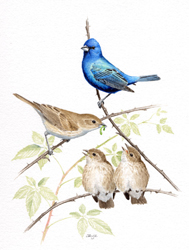Breeding Bird Atlases (BBA)
Find a Bird - BBA1
Breeding Bird Atlas 1 Species Accounts
Indigo Bunting
Passerina cyanea
Egg Dates
June 1 to June 28
Number of Broods
one or two

The Indigo Bunting was probably a more common breeding bird in Massachusetts years ago, when its favored habitat of brushy farmland was more prevalent. Now that abandoned farmland has returned to forest, the Indigo Bunting is a rather uncommon migrant and summer resident throughout the state. On Cape Cod, Nantucket, and Martha’s Vineyard, it has always been rare. Its preferred habitats are woodland edges adjacent to fields and highways, overgrown pastures, power lines, and hedgerows.
Indigo Buntings do not begin arriving in Massachusetts until mid-May, but nearly every year varying numbers of premature arrivals, mostly males, turn up a month or more ahead of time, the result of southerly storms and migratory miscalculation. The males arrive first and set up territories by singing from high conspicuous perches. Singing is most vigorous in early morning and evening. First-year males may challenge older males for their territories by flying toward them. During these flights, they sing, fluff out their body feathers, and move in a slow, stalling manner with a rapid wing beat. New males may gradually adapt their song to sound like older males. For this reason, the songs of males in a given area all have similar phrases. Territories range from 2 to 6 acres.
Once the females arrive several days later, the males may chase them about persistently, singing or giving a high zeep call. There is still much that is not known about the courtship activity of these birds. Generally, the females are inconspicuous and stay in the cover of vegetation; in fact, in most cases it is hard to tell when they have arrived on a territory.
Nests are placed low in brambles, shrubs, or saplings, usually no more than 10 feet high. The female selects the site and does all of the building. In Massachusetts, nests have been located in raspberry, blackberry, barberry, hazelnut, ash, and rose (EHF, ACB, CNR). Heights ranged from 2 to 3 feet (EHF, CNR). The nest is a thick-walled cup of leaves, grasses, and plant stems placed in a crotch of branches. An excellent clue to the presence of a nest is that both birds utter a sharp chip call whenever they are approached within 40 feet.
During egg laying, the male stays closer to the female than at any other time in the breeding cycle, but once she is incubating he stays away from the nest to sing and feed. The eggs are white and unmarked, and average three to four per brood. Clutch sizes for 3 state nests were three eggs (2 nests) and four eggs (1 nest) (DKW, CNR). The female does all of the incubation for 10 to 12 days. Once the young have hatched, the female provides most of the care, and she is very secretive as she approaches and leaves the nest. The male’s role is to guard the nest area from predators. Brood sizes for 3 state nests were one young (1 nest) and four young (2 nests) (Meservey, CNR).
The young hatch naked except for a few tufts of down. Their eyes open at 4 or 5 days, and they are feathering out by day 6. Fledging occurs between 8 to 10 days of age. By day 11, they make short flights. In Massachusetts, nestlings have been observed from June 16 to August 12, and fledglings have been recorded from July 2 to September 6 (CNR, Meservey). Approximate hatch dates for 2 state nests were June 16 and August 5 (CNR, Meservey). Two of four young in a Lincoln nest fledged on July 2 (CNR), and a nest in Spencer contained a single nestling near fledging age on August 12 (Meservey).
During the fledging phase, which lasts from two to three weeks, both the male and female feed the young. The fledglings remain scattered in the shrubbery and give persistent psink calls, which help the parents locate them. If there is a second brood, the male will take over the care of the fledglings while the female builds the new nest.
Parents and young often remain together until they are ready to migrate south. During this time, adults undergo a complete molt, and the brilliant blue of the male is replaced by a rich brown. Migration starts in late August and continues through October. Most of the population winters in southern Middle America.
Map Legend and Data Summary
Atlas 1 data collected from 1975-1979


Note: uncommon to common throughout most of the state in second-growth and woodland edges; rare on the Cape and Islands
Donald W. Stokes and Lillian Q. Stokes



